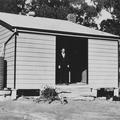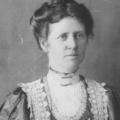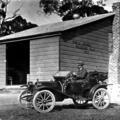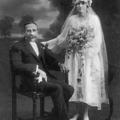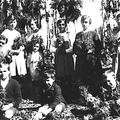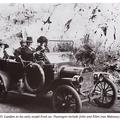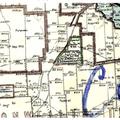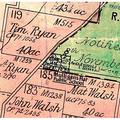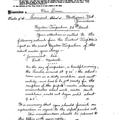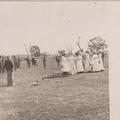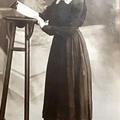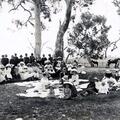< Early Canberra Government Schools
Mulligans Flat School [1896 - 1931]
An initial application for a Provisional school at Mulligans Flat was made in 1894, and a two acre site on the Gundaroo Road, Goorooyarroo Parish, was selected. The first school (1896) was a wooden slab building with a bark roof, built by local volunteers, and the first teacher was James Gibson. Teachers frequently boarded with the nearby Cavanagh family. At least three lady teachers married local men.
In 1910 the school had an enrolment of twenty, coming from eight local families. The enrolment record shows that three of them were the children of William Ryan (John, David and Elizabeth Ryan), five of Edward Ryan (Timothy, William, Francis, Honora and Josephine), five of Thomas Jones (Elsie, Sarah, Lionel, Hautrey and Lydia), three of Frederick Mundy (Ann, Ivy and Septimus), While Maurice Cavanagh (Mary) , Edward Gozzard (Eliza), Patrick Cavanagh (Ernest), and William Winter (Amos) each had one child enrolled.
A new, more substantial school was built in 1913 – a weatherboard structure 15 feet x 101/2 feet x 7 feet, with corrugated iron roof, in the same design as Hall school. Cornelius O'Rourke was the contractor, and the total cost was £154.12.6. The 'old slab hut' lived on as a lunch shelter.
In 1918 Mr J.E. Hollingsworth of Hall was contracted to construct a fence around the school yard. The confirmation of his contract came only after months of wrangling between the NSW and Federal governments over who was to be responsible for such matters. In the midst of the argumentation Hollingsworth sued for compensation. On Arbor Day in 1920 a double row of young pine trees, fetched by trap from the new Yarralumla Nursery by teacher Ethel Harris, was planted around the perimeter of the school by the students. They can still be seen.
By August 1921 there were only nine pupils, and the NSW department proposed to close the school. Secretary Peter Board wrote advising the parents of the options available to them: a subsidy to engage their own teacher, enrolment in the Correspondence School, subsidies for conveyance to another nearby school, or a boarding subsidy. However, the Commonwealth Surveyor General, weighed in on behalf of the parents, and paymaster, telling the NSW government that the Commonwealth wished the school to continue. A modest sum was spent on refurbishments (₤14) and from March 1922 the school was kept open 'as a special case', operating Half Time with Tallagandra, which also had nine pupils. Reginald Percival was the teacher, followed by Reginald Lynch, and in 1923 by James Gormly. This arrangement continued until August 1926 when Tallagandra closed. Mulligans Flat reverted to Provisional school status in 1927, and finally closed in May 1931
The school site is in the south west corner of the Mulligans Flat Nature Reserve, surrounded by the Gungahlin suburb of Forde.
Australian Capital Territory. Heritage (Decision about Provisional Registration for the Old Coach Road, Gungahlin) Notice 2011. Extract:
In 1894, as a response to the growing community of young families in Ginninderra, land was set aside for a small school at Mulligans Flat. The land was selected by the NSW Department of Education School Inspector, M. Willis, at the junction of Gundaroo Road and the recently constructed road to the Bungendore railhead (Old Coach Road). The site would have been readily accessible as both these roads were well-used transport links at the time. The inspector recommended that the local residents with school-age children provide a suitable building for the students. However, it was not until April 1896 that a building was erected and the first students began to attend the school with James Gibson as the first teacher. It began operation as a Provisional School. Provisional schools were established in rural areas where an attendance between 15 and 25 students could be expected and were under the charge of an itinerant teacher. They later became known as half-time schools with one teacher operating two schools in nearby areas.
There were two buildings erected on the site, one probably in late 1895 and a second in 1913. There are two varying descriptions of the 1895 schoolhouse. The earlier source by a former teacher at the school (Mcleod 1976) described the structure as being built in 1890 (almost certainly the wrong date) with timber slab walls, iron roof, boarded floor with a ceiling lined with hessian covered with paper for insulation. Water for the students was provided at first from a cask filled by rainwater from the iron roof and later by a square iron ship's tank donated by William Ryan from the neighbouring property of Horse Park. A second description (Gillespie 1999:41) has the schoolhouse constructed in 1895 as a simple slab structure measuring 18 feet by 10 1⁄2 feet by 7 feet high (4.5m by 3.2m by 2.1m) with a shingle roof and probably with just a single-room.
In later years this building was found to be insubstantial and uncomfortable for the students. In 1913, following an application by local residents, a new government school was erected on the site. Ethel McLeod (nee Harris) a schoolteacher at Mulligans Flat between 1917 and 1921 described it as:
'...at that time a quite modern and commodious building, weatherboard, iron-roofed, pine lined and ceiled, well ventilated with three large windows and a hat, bag and washing porch running the full length of one side. Two good corrugated iron tanks were provided and two pit toilets well up the school ground, but no shelter shed' (McLeod 1976).
This building was designed on a plan for New South Wales School Board plan and measured 18 feet by 171⁄2 feet (5.4m by 5.3m). A shelter-shed was later built on site for the students with funds raised by a dance night in the Horse Park Granary (McLeod 1976). Photographic evidence of the second school shows that it was a single room building constructed of weatherboard with a gabled roof of corrugated iron. The building was supported by stone and brick footings. Two concrete steps led up to a wide doorway. A circular corrugated iron tank resting on a circular stone and concrete base was connected by downpipes to the tank (Gillespie 1999).
The pine trees on the site date between 1917 and 1921. The Yarralumla Nursery donated the pine saplings to the school and Ethel Harris organized the children to plant them as a boundary around the yard. The older boys were responsible for digging the holes in the hard ground for the seedlings and the young girls, along with their teacher, were responsible for the alignment, measuring, planting and staking up the saplings (Mcleod 1976).
The school operated often as a half-time school but because of fluctuating numbers of students and the difficulty in keeping teachers it closed between October 1907 and May 1910 and again between October 1921 and March 1922. The school finally ceased operating in May 1931. By that time the young students in the Ginninderra region were attending several other schools and there were few from the immediate surrounds that would attend the small Mulligans Flat School. During its periods of operation 18 teachers were assigned to the school – most served for periods of less than 2 and 1⁄2 years; the longest to serve were Ethel Harris (later McLeod) 4 years 7 months and James Gormly for 3 years 7 months (Gillespie 1999:154). When it closed the school building, shelter shed and associated structures were dismantled, removed from the site and sold.
The Mulligans Flat School Ruin is situated on the junction of the former Old Gundaroo Road and Old Coach Road.
Little now remains on the surface of these two former school buildings, as both were largely timber constructions. Broken and scattered remains of the concrete front steps, stone and concrete footings of a circular corrugated iron tank stand are all that remain visible on the surface. Photographic evidence suggests that this material is associated with the second schoolhouse erected on the site in 1913. Several mounds and depressions and ground surface irregularities mark the site of the school building. There is a high possibility of sub surface remains, particularly relating to the second schoolhouse and possibly artefacts relating to the activities of the school and students within the former school yard.
The site is bordered on 4 sides by plantings of pine trees (Pinus radiata), which once formed the boundary of the schoolyard. The pine trees were planted by the school children between 1917 and 1921 and are nearing senescence - several have died and fallen. Another remnant species associated with the former school is a Photinia sp. which would have grown in front of the former school house.1`
The Queanbeyan Leader, Friday 7 December 1906
"A very successful social was held in Mr. Ryan's (Horse Park) woolshed on Friday night, 16th, in aid of a fund to provide a weathershed and library for Mulligan's Flat school. The music (piano and violin) was supplied by Miss Casey, and Messrs. Lake, Casey, and Kinleyside, while Mr. J.Bolton acted as M.C. The refreshments, which were tastefully laid on tables in Mr. Ryan's dining-room, were provided by the ladies of the district, and spoke volumes for the capabilities of the fair cooks. Mr. Gillespie thanked all present on behalf of the teacher (Miss Burrell) for the assistance rendered in bringing the social to such a successful issue".
Location Map
Related Photos
Teachers
- Gibson, Mr James
04/1896 - 07/1898 - Johnstone, Mabel May
09/1898 - 09/1898 - Fenton, Mary Ann
09/1898 - 08/1899 - Lake, Mr Herbert A.
08/1899 - 06/1900 - Lake, Mr Thomas A.
1900 - 1903 - Dunn, Flora Australia
03/1903 - 07/1905 - Burrell, Margaret Ann
07/1905 - 10/1907 - Landon, Henry Osborne
05/1910 - 05/1915 - Yabsley, Mr F F D
04/1915 - 05/1918 - Collier, Stephen
07/1915 - 08/1915 - Southwell, Albert Clive
08/1915 - 12/1916 - Ward, Laurie
01/1917 - 02/1917 - Cavanagh (nee Harris), Mrs Ethel
1917 - 1921 - Lynch, Reginald
09/1922 - 12/1922 - Percival, Reginald
1922 - 1922 - Gormly, Mr James
01/1923 - 08/1926 - Crofts, Henry A.
1926 - 1927 - Burgess, Dora
1928 - 1929 - Sexton, Margaret
1929 - 1931
Related Documents
Stories:
- Stories - Mulligans Flat (PDF 59.6 kb)
Maps - current topographic:
- Mulligans Flat Parish map (1) (PDF 1.1 Mb)
- Mulligans Flat Parish map (2) (PDF 889.6 kb)
- Mulligans Flat Parish map (3) (PDF 1.1 Mb)
- Mulligans Flat Parish map (4) (PDF 1.1 Mb)
Teacher biographic:
- Landon's Farewell (PDF 57.3 kb)
NSW Government schools from 1848
- Mulligans Flat School (external link)
< Early Canberra Government Schools
If you are able to assist our work of identifying, documenting, and celebrating the early bush schools of the Canberra region, please contact us or .


